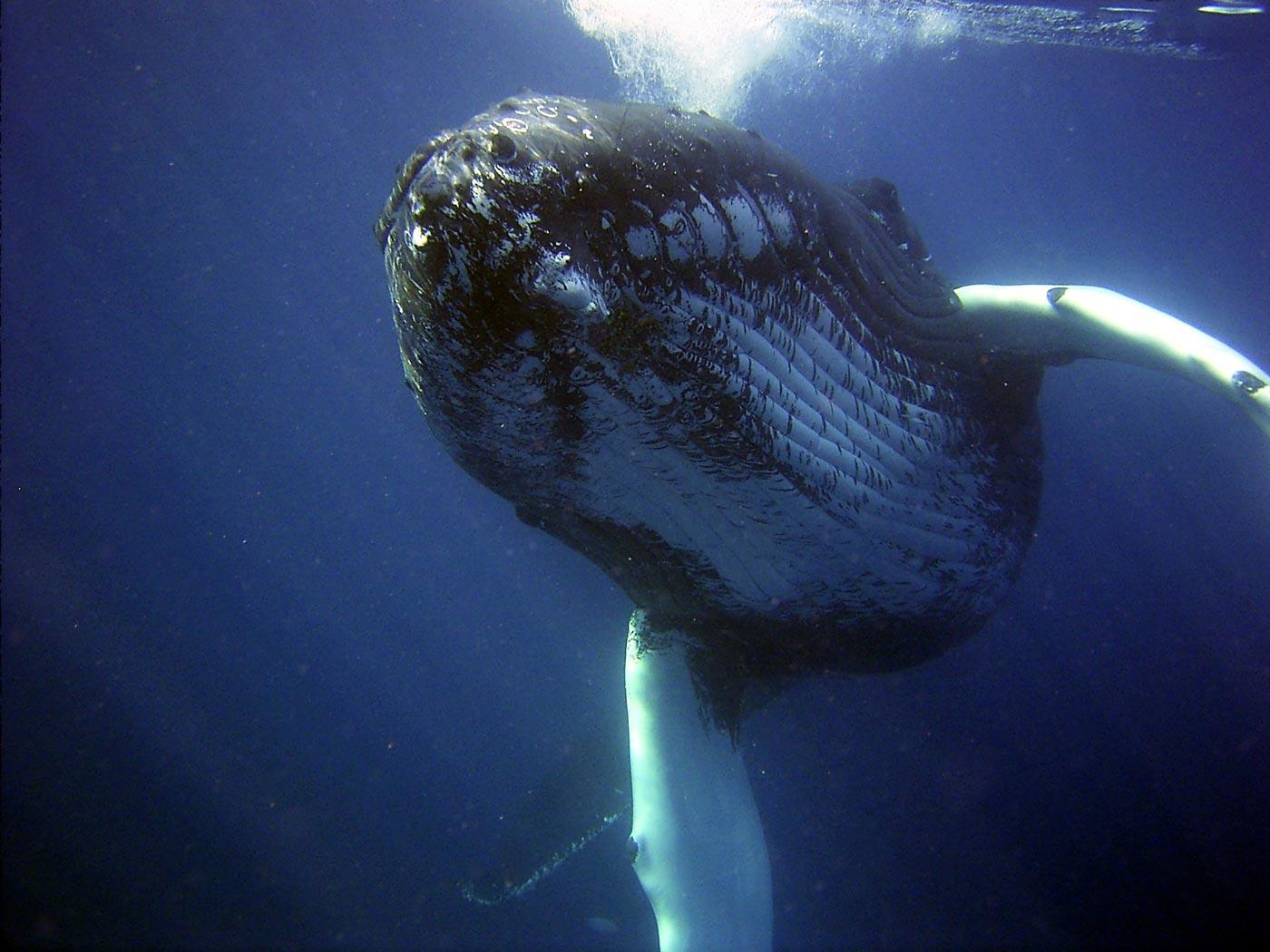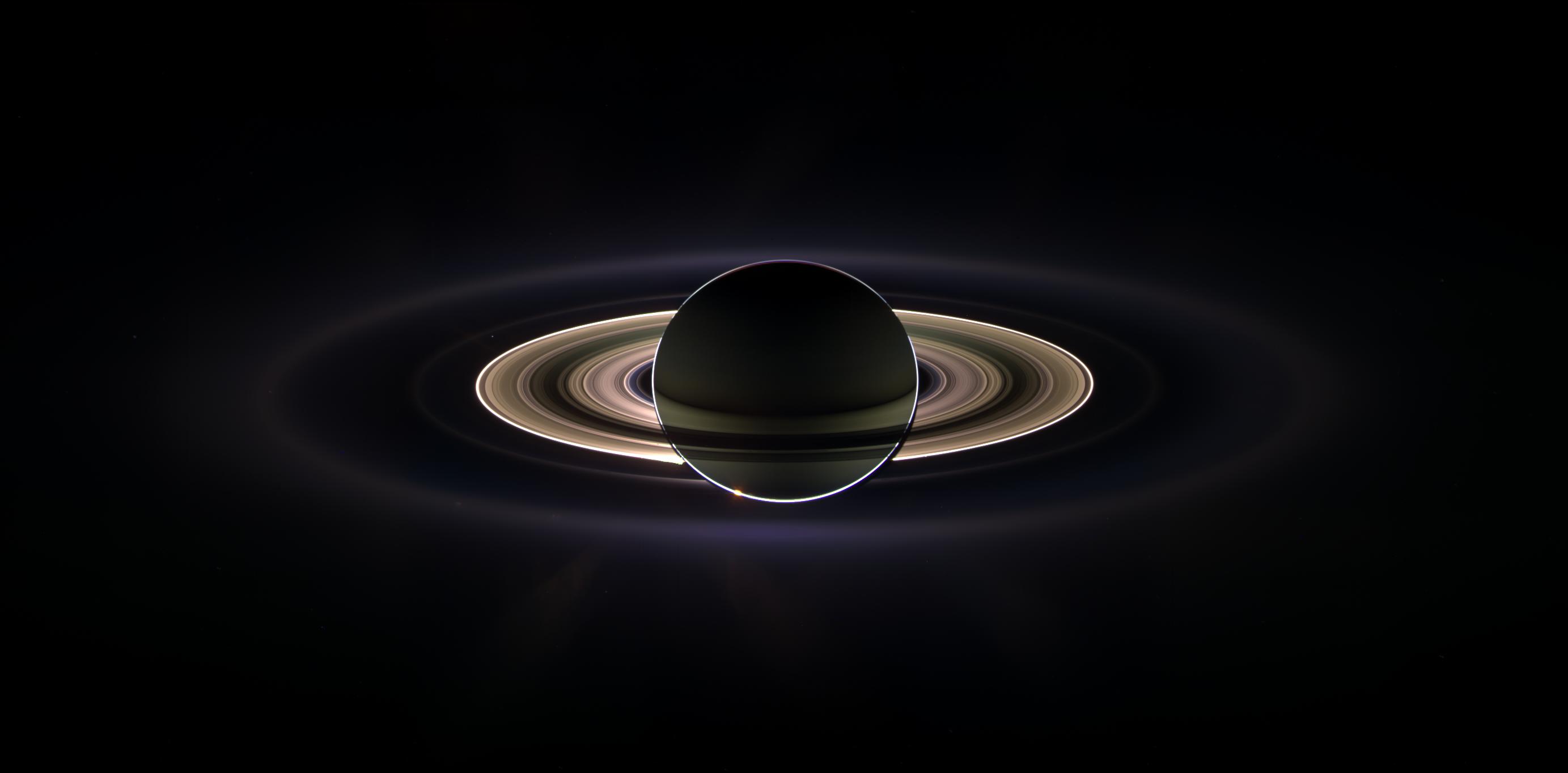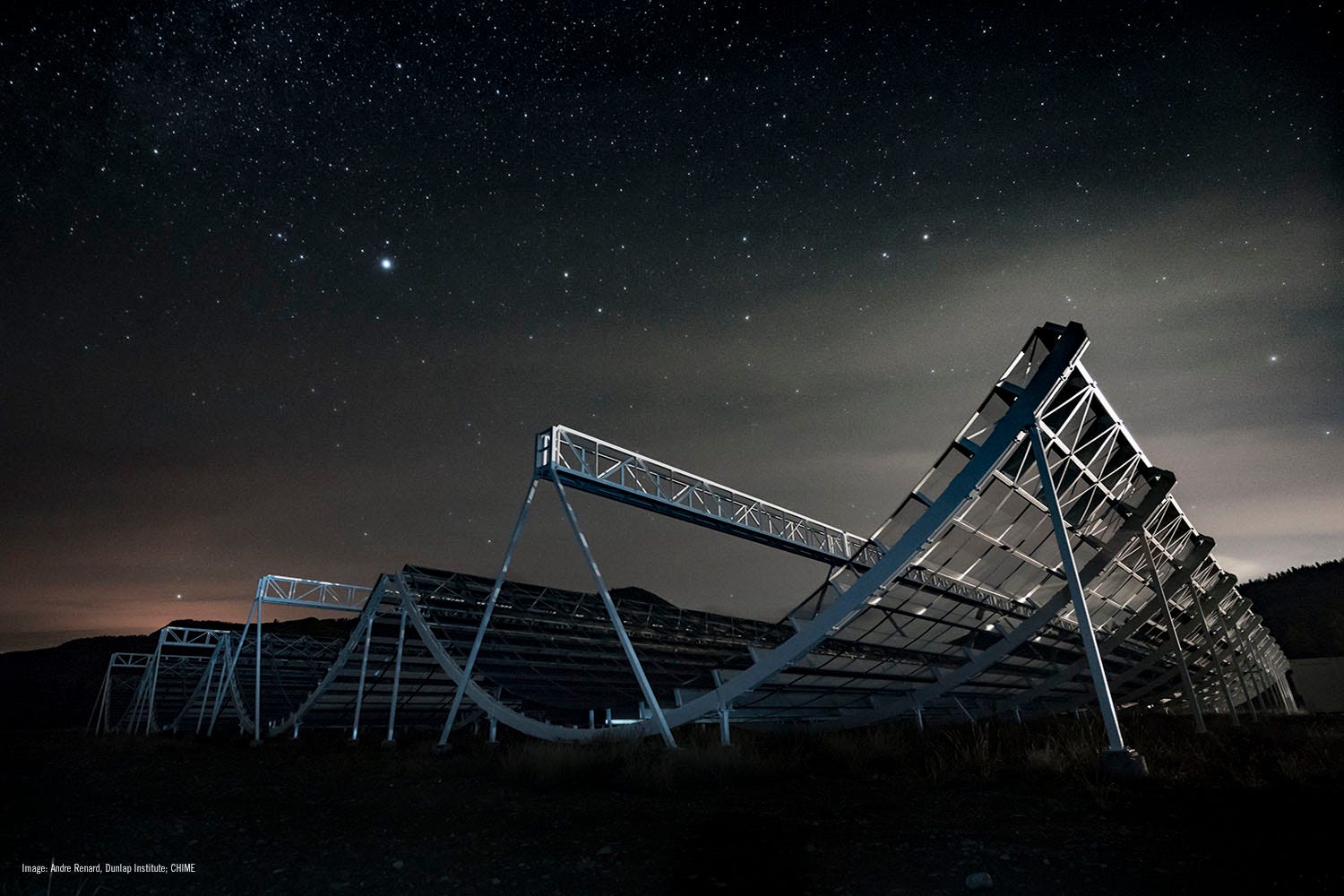
Are we alone? The SETI Institute’s mission to explore, understand, and explain the origin and nature of life in the universe and the evolution of intelligence generates many questions. SETI Institute research scientist Laurance Doyle wants to know how we might recognize and comprehend an extraterrestrial language if we were to encounter one, and he’s consulting a local, earthly source: humpback whales. Medium recently profiled Doyle’s research:
Unlike other intelligent animals, like monkeys, Doyle says, “humpback whales and bottlenose dolphins depend upon signals that are acoustic,” whereas other creatures can also rely on body language cues. “Therefore, we can obtain and classify the different units of their signaling systems and [be] sure that we’re getting all of them, because humpback whales generally don’t gesture or smile.” Humpback whales happen to be one of the most socially complex animals on earth. “[They] form long-lasting relationships based on profession, just like humans,” Doyle says. “They’re the only other species known to do that.”
There’s another reason why whale communication could help researchers prepare to converse with a distant alien civilization:
“Humpback whales send messages to each other across long distances,” Doyle explains. “They wait, maybe for hours, for a reply.”
The light-time communication in space means big delays in response, something whales have adapted to but humans would need to learn if we were to start a conversation with a distant species.
- Medium: Meet the Alien Whisperer
- Thrive Global: Humpback Whale Communication and the Search for Alien Intelligence
- SETI.org: Scientist Interview - Laurance Doyle - A Man of Many Firsts
 Unlocking the Secrets of Saturn
Unlocking the Secrets of SaturnSaturn may be as enigmatic as it is beautiful – until quite recently, astronomers didn’t know how long the Saturnian day lasted. “Saturn is the only planet whose rotation is hard to measure,” explained Matthew Tiscareno, Senior Research Scientist at the SETI Institute, in a recent National Geographic article. Due to the clouds enveloping the gas giant, surface features are impossible to track. Saturn’s magnetic field isn’t tilted like those of the other gas giants, preventing astronomers from figuring out the rotation based on the disturbances caused by the field’s wobble. The key to finding the length of a day on Saturn lay in looking at its rings, as a recent study published in The Astrophysical Journal revealed. By measuring ripples in the rings caused by oscillations in the planet’s interior, researchers were able to determine Saturn’s rotation.
By the way, the answer to the question, how long is a day on Saturn? 10 hours, 33 minutes and 38 seconds.
Another story, published on Mother Nature Network, revisited the age of those rings which are believed to be surprisingly young, geologically speaking. Up until 2016 researchers believed the rings were as old as the planet, only to find they were likely formed quite recently. In a 2016 article on Phys.org, SETI Institute… Matija Ćuk explained:
"Moons are always changing their orbits. That's inevitable," says Matija Ćuk, principal investigator at the SETI Institute. "But that fact allows us to use computer simulations to tease out the history of Saturn's inner moons. Doing so, we find that they were most likely born during the most recent two percent of the planet's history.
Ćuk and his team used computer modeling and results from NASA’s Cassini mission to analyze Saturn’s rings and moons, and found the data shows them to be a mere 100 million years old – young enough to have formed during the age of dinosaurs.
- National Geographic: How long is a day on Saturn? Astronomers just found out.
- Mother Nature Network: Saturn's famous rings may not have existed when dinosaurs first evolved
- Phys.org: Moons of Saturn may be younger than the dinosaurs
 Experts from Many Parts of the World Enrich the SETI Institute
Experts from Many Parts of the World Enrich the SETI InstituteThe San Jose Mercury News presented a story about the prevalence of H-1B workers in the California Bay Area, many working for tech companies in the area. The piece profiled Mike Evans, a SETI Institute research scientist from the UK:
Evans’ background is on the Cassini mission, a joint program from NASA and two European space agencies that sent a probe to orbit Saturn for more than a decade before it was intentionally crashed into the planet in 2017. Evans had worked on Cassini for 19 years — his entire professional career. At SETI, he’s working on archiving the probe’s observational data. He estimated that maybe five people in the world have the kind of experience he has. “And all five are working in the U.S.,” Evans said.
While some see H-1B visas as a way for companies to undercut American workers, the SETI Institute is a unique organization that seeks talent based on qualifications, not visa status, and astronomers and researchers are hired only if they already have government or private funding for specific projects. Bill Diamond, President & CEO of the SETI Institute, supports hiring employees with special skills and experience to further the SETI Institute’s goals and mission:
“I think we feel very comfortable in the fact that if somebody comes to the Institute with a specialized degree and capability, we haven’t hired them at the expense of some other poor astronomer in the U.S. not getting a job,” said Bill Diamond, SETI’s CEO. “There’s just not enough of the kinds of scientists we want to bring in.”
The broad, multi-disciplinary research undertaken by the SETI Institute in particular benefits from employees with diverse perspectives and backgrounds, Diamond explained:
“You want to bring as many new sources of knowledge and information and understanding as you can on the kind of work we do,” he said. “To restrict that in any way would be problematic, both to us on a micro-scale, but more broadly to science.”
You can read more about Evans’s work, and see what it takes to become a principal investigator at the SETI Institute, on SETI.org.
- San Jose Mercury News: H-1B visas: The Bay Area’s non-tech employers seek foreign workers, too
- SETI.org: Become a Principal Investigator at the SETI Institute
 ‘Oumuamua Continues to Inspire Speculation
‘Oumuamua Continues to Inspire Speculation‘Oumuamua, the first known interstellar object to pass through our solar system, has thrilled and perplexed astronomers since its discovery in 2017. Speculations that it may not be of natural origin – that it may be evidence of extraterrestrial technology – floated around from the start, but reached a fever pitch following a research paper by Avi Loeb, chair of the astronomy department at Harvard. Loeb proposed the possibility that the object’s strange characteristics suggest that, rather than a very odd comet, ‘Omuamua could be a lightsail. This has triggered a great deal of media buzz, as an article for the Atlantic recently commented on.
While the majority of researchers find it unlikely that aliens constructed the object, the idea was tested: scientists at the SETI Institute used the Allen Telescope Array to observe ‘Oumuamua for artificial transmissions. None were found, but as Seth Shostak, Senior Astronomer for the SETI Institute, points out in the Atlantic, the story is far from over:
“That doesn’t necessarily prove anything, of course,” says Seth Shostak, an astronomer at the SETI Institute. “The fact that we didn’t pick up transmissions doesn’t rule out the possibility that [‘Oumuamua] could be something directed here”
That said, Shostak warns against getting overly excited, saying, “History is on the side of skepticism when it comes to this stuff”. With ‘Oumuamua now out of reach, insight might be gained by discovering more interstellar objects and testing them further for signs of extraterrestrial technology.
For Dutch-speaking readers interested in learning more, Shostak appeared on the Netherlands radio station, BNR Newsradio, to discuss the questions surrounding ‘Oumuamua.
- The Atlantic: When a Harvard Professor Talks About Aliens
- SETI.org: A Radio Search for Artificial Emissions from 'Oumuamua
- BNR Newsradio: The Mysteries of Oumuamua
 Fascinated by FRBs
Fascinated by FRBsFast radio bursts (FRBs) continue to draw widespread interest following the announcement of another repeating FRB by the Canadian Hydrogen Intensity Mapping Experiment (CHIME). FRBs are powerful bursts of radio waves that last only seconds, and so far only two have been detected that repeat, as SETI Institute Senior Astronomer Seth Shostak explained to the Redding Record Searchlight:
"Almost all of these have only been measured once," Shostak said. "You see this happen — 'beep!' — and then you don't hear it again. You can sit there and look at it (recoded data) for weeks, and you never 'hear' it again. That makes it problematic because whenever in science you only measure something once, it's pretty hard to figure out what it is you're dealing with."
The origin of the signals is unknown, leading to a speculation that they are caused by anything from collapsing black holes to alien communication:
"Some people have suggested that you shouldn't rule out the possibility that this is some kind of alien signal, that maybe it's the Klingons trying to get in touch, or maybe it's a navigation beacon for them, or something like that," Shostak said. "You can cook up some scenarios in which it might be possible."
Shostak remains skeptical, however:
“You see a fast radio burst over there in the sky, and then you find another fast radio burst over here in the sky, and these places are billions of light years apart." If aliens are sending messages, "how is it they've all been organized to produce these fast radio bursts? It takes billions of years to send a message from one galaxy to another.”
While FRBs are likely to be a natural phenomenon, they nonetheless represent an increasingly fascinating area of astronomical research.
- Record Searchlight: Mysterious chirps in deep space may be 'colliding black holes,' Hat Creek astronomer says
Big Picture Science
In last week’s episode, embrace the multitude of life living on us, in us, and in every possible ecological niche, in Rip Van Winkle Worm. On our previous week’s episode, sand, one of the most used building materials in civilization’s history, is running out! Grab your hourglass and give a listen to True Grit.
Last time on Facebook Live, CEO Bill Diamond dives (figuratively) into the habitats of the cryosphere with Tyler Mackey, a Postdoctoral Fellow at Massachusetts Institute of Technology. Videos of all past Facebook Live events can be found on our Facebook page: https://www.facebook.com/SETIInstitute/
- Benjamin Dean Astronomy Lectures: New Approaches to Looking for E.T.: February 11, 2019, California Academy of Sciences, San Francisco, CA Seth Shostak is the featured speaker
- TESS Data Workshop: February 11-14, 2019, Baltimore, MD SETI Institute scientist Jeffrey Smith is one of the scheduled speakers
- American Association for the Advancement of Science Annual Meeting: February 14-17, 2019, Washington, D.C.
- San Mateo County Astronomical Society: March 1, 2019, College of San Mateo, San Mateo, CA SETI Institute scientist Michael Busch will present Near Earth Asteroid Hazards, Research and Space Missions
- Kepler &K2 Science Conference V: March 4-8, 2019, Glendale, CA SETI Institute scientist Douglas Caldwell will present The Kepler Photometer
- 50th Lunar and Planetary Science Conference: March 18-22, 2019, The Woodlands, TX





